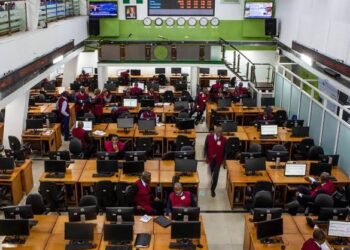Data recently published by the Central Bank of Nigeria (CBN) reveals that the total currency in circulation across the country has surged to N4.14 trillion, with a staggering N3.87 trillion of this sum circulating outside the banking system.
This means that approximately 93.34 percent of Nigeria’s total currency is in the possession of individuals and businesses, leaving only a small fraction—6.66 per cent—within the formal banking sector.
This situation presents a considerable challenge for the country’s banking industry. Despite various initiatives aimed at boosting financial inclusion and encouraging the adoption of cashless transactions, a significant chunk of Nigeria’s currency supply remains outside regulated financial institutions.
The disparity between the currency circulating outside the banks and the total amount in circulation suggests that Nigerians, particularly those in rural or underserved areas, still rely heavily on cash for everyday transactions. This reliance persists despite the growing availability of digital banking services, such as mobile banking apps and digital wallets.
Moreover, the CBN data also highlighted a dramatic year-on-year (YoY) increase in the amount of currency in circulation. The total rose by N1.48 trillion, representing a 55.8 per cent surge from N2.66 trillion in August 2023 to N4.14 trillion by August 2024. This steep rise emphasizes the country’s increasing cash demand over the past year.
In August 2024 alone, the reported N4.14 trillion represented a 2.25 per cent increase, or about N91.08 billion, from the N4.05 trillion recorded by the CBN in July 2024. A month-by-month breakdown of the data shows interesting trends in Nigeria’s currency circulation throughout the year.
January 2024 began with N3.65 trillion in currency circulation. This stable figure mirrored the usual post-holiday economic pattern, reflecting moderate economic activities as businesses returned to normal operations after the festive season. By February 2024, the currency in circulation had inched up to N3.69 trillion, an increase of N43 billion or 1.18 per cent from the previous month.
In March 2024, a more noticeable increase took place, with the total currency in circulation climbing to N3.87 trillion. This marked a month-on-month rise of N175 billion, or 4.76 per cent. The upward trend continued into April 2024, with the currency in circulation hitting N3.92 trillion. This represented a N53 billion increase, or 1.39 per cent, from March, likely driven by economic activities and heightened consumer spending during the Easter season.
By May 2024, currency circulation had grown further to N3.97 trillion, a N42 billion rise from April, or about 1.07 per cent. The most significant increase occurred in June 2024, when the total reached N4.04 trillion. This N84 billion surge, representing a 2.11 per cent growth from May, set the stage for the steady rise that culminated in the N4.05 trillion reported in July 2024.
It is important to note that when Mr. Olayemi Cardoso took over as the Governor of the Central Bank of Nigeria in September 2023, the currency in circulation stood at N2.76 trillion. Under his leadership, the increase in currency circulation has been remarkable, reflecting both the challenges and the monetary strategies being employed by the CBN.
During a recent Monetary Policy Committee (MPC) meeting, Cardoso addressed the issue of money supply. He stated: “Over N4 trillion in July, I know from my internal sources that another N1.4 trillion is likely to be delivered in another three months to aid that whole process of cash within the system and cash velocity. From our perspective, I think we are doing everything possible to ensure that there’s sufficient cash in the system, that’s that side of them, and there’s no excuse for not having sufficient cash in the system. Now it goes to the deployment of that cash.”
This comment underscores the CBN’s commitment to ensuring that there is an adequate supply of cash in the system while focusing on how effectively that cash is deployed to stimulate economic activities.
The consistent rise in currency circulation, while indicative of growing economic activity, also highlights the challenges faced by Nigeria’s banking sector, which continues to grapple with an under-banked population and the slow adoption of digital financial solutions. Financial inclusion remains a pressing goal for the Nigerian government and the CBN, as they work toward integrating more Nigerians into the formal banking system and reducing the volume of currency circulating outside regulated institutions.
Additionally, the steep increase in currency circulation can be attributed to a variety of factors, including inflationary pressures, the demand for liquidity in both formal and informal markets, and the broader macroeconomic environment. For Nigeria, the persistent use of cash is a reflection of both cultural norms and economic realities, as many individuals and businesses still prefer physical currency over digital alternatives for their transactions.
In conclusion, while the Central Bank of Nigeria is working to ensure sufficient liquidity in the economy, the enormous amount of currency outside the banking system poses a significant challenge. It highlights the need for continued efforts to boost financial inclusion, promote the use of digital banking solutions, and address the structural barriers that keep large portions of the population reliant on cash transactions.

































